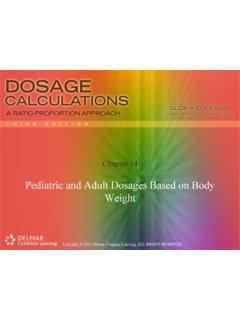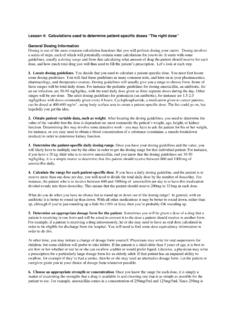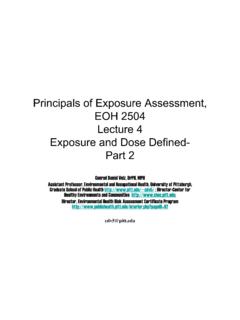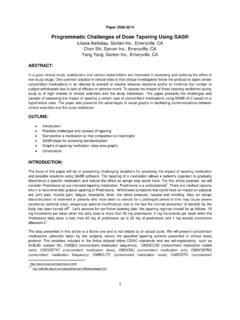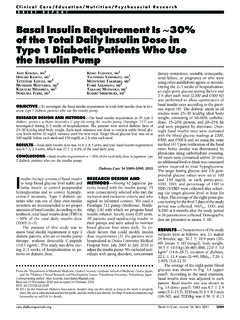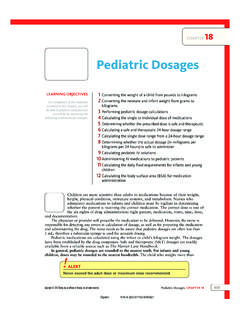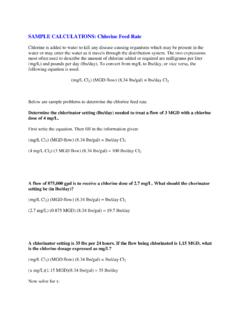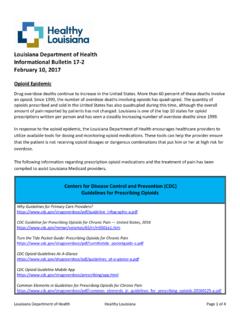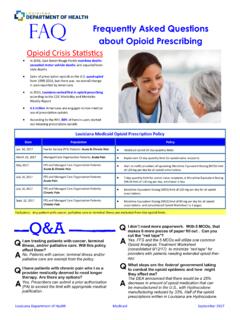Transcription of Calculating the Estimated Dose for Exposure to Ionizing ...
1 15 Calculating the Estimated dose for Exposure to Ionizing RadiationThe Estimated dose (ED) for Exposure to Ionizing radiation can be calculated by adding up all expo-sures received in a year from various pathways and can be represented by the following equation:ED=EDexternal + EDinternal=EDexternal + EDa + EDw + EDs + EDfEDexternal is the direct external irridiation received in a year. EDinternal is the dose that will be received overthe next 50 years (adults) or 70 years (children), from all radionuclides taken into the body in thecurrent year, specifically:EDa is the Estimated committed dose from radionuclides inhaled through the air,EDw is the Estimated committed dose from radionuclides taken in by drinking water,EDs is the Estimated committed dose from radionuclides taken in by eating soil,EDf is the Estimated committed dose from radionuclides taken in by eating calculate the Estimated committed dose from internal radionuclides, an equation of the followinggeneral form is used for each radionuclide for each pathway:EDx = C x CR x CF x EF x DCFwhere,EDx= Estimated Committed dose over 50 years (adults) or 70 years (children) from a specificradionuclide taken into the body in the current year (Sv) for a specific pathway x (airinhalation, and water, soil or food ingestion).
2 C=Concentration of the radionuclide in the Exposure pathway being considered ( , Bq/L forradionuclides in water).CR=Contact Rate:The amount of water, food, air, etc., which is taken into the body in oneday. Typical units for food are grams per day (g / day) and litres per day(L / day) for Factor: The factor of 365 days is required to convert the Contact Rate (CR)from units/day to Factor:This factor indicates how often the individual is exposed during a is needed especially when Exposure does not occur daily , such as atwork (only five days a week) or when related to seasonal activities(swimming in the summer).DCF = dose Conversion Factor:This factor converts the amount of radionuclide taken into thebody via inhalation or ingestion, in becquerels, to the extended 50-year(adults) or 70-year (children) dose in sieverts. DCFs are usually ex-pressed as Are the Recommended Limits to Radiation Exposure ? dose limits for radiation Exposure , from artificial sources, for thepublic have been issued by the International Commission on Radio-logical Protection (ICRP), and have been set at 1 mSv per year.
3 Implicitin this limit is the understanding that exposures must be as low asreasonably achievable. This limit is in the process of being adopted bythe Atomic Energy Control Board (AECB) of Canada. It applies to thetotal dose received from all internal and external sources, but does notinclude the natural background radiation that ever yone is exposed toor exposures received for medical purposes. Actual doses received bythe public from artificial sources are much lower than this tificial sources include levels of natural radionuclides that have beenenhanced due to human practices such as uranium mining. In addition,the total dose at the site boundar y of nuclear facilities may not mSv in a year as stipulated by the AECB. By comparison, the dosereceived from the natural background radiation is about 3 mSv Canada has issued guidelines for radionuclides in drinkingwater. The total dose received from the consumption of drinking watershould not exceed mSv per year, and this includes the dose from allradionuclides that exist naturally in the environment, as well as thosethat are artificial.
4 This level of dose corresponds to a theoretical risk ofabout five extra cancer deaths per million people STEP-BY-STEP APPROACH FOR ESTIMATING EXPOSURETO ENVIRONMENTAL CONTAMINANTSThis handbook focuses on steps four, five and six - Calculating theEstimated daily Intake of chemicals and the total Estimated dose ofradiation - of the following flow char t. For more information on stepsone through three, see the companion Community Handbook .STEP 1 Identify the contaminant of concernSTEP 2 Identify all pathways of Exposure for that contaminantSTEP 3 Obtain the concentration of the contaminant or the radionuclide activity concentration in each pathwaySTEP 4 Estimate the annual dose from all external radiation sources and the committed dose from radionuclides taken into the body during the year. Sum to calculate the total Estimated dose (ED)STEP 4 Estimate the daily intake (ED) of the contaminant for each pathway and sum to calculate EDISTEP 5 Compare the calculated ED received and committed in the current year with the 1 mSv per year dose limit.
5 Compare the dose from drinking water with the mSv per year Health Canada guidelineSTEP 5 Compare the calculated EDI to the available TDI (non-carcinogen) or RsD (carcinogen) STEP 6 Decision: is total ED received and committed in the current year from all radiation sources a concern? Is the dose received from drinking water in the current year a concern?STEP 6 Decision: is EDI for the contaminant a concern? Ionizing RADIATIONCHEMICALS daily INTAKE FOR CHEMICALS:EQUATIONS AND EXAMPLESThis section describes how to carr y out the calculations for the Esti-mated daily Intake of a chemical contaminant. It also gives advice onwhat values to use in the equations and includes tables of averagevalues that can be used when you have no specific, local and InferencesMany subjective judgements are made in the process of calculatingexposures using the many precise formulas available. This happensbecause some of the information for equations is not available, orvalues that are available do not accurately reflect the real variations inareas such as the concentration of contaminants in the air, soil, waterand food.
6 Many of the assumptions and judgement calls that may bemade during an Exposure assessment are highlighted below: How should the movement of contaminants through the environ-ment be predicted? A specific example of this question is: Howshould the dispersion of air pollutants in the atmosphere due towind currents be predicted? How should the size and nature of the population potentiallyexposed to the contaminant be Estimated ? Can the exposuremeasurements taken from a small segment of the community beapplied to the entire community and, if so, how should this done? How should patterns of human activity, such as variations in diet,lifestyle and hobbies, be taken into account? How should differences in Exposure to the contaminant, such astiming, duration and age at first Exposure , be Estimated ? How should the breathing rate, water and food consumption,body weight and surface area of the potentially exposed popula-tion be Estimated ? How should exposures of special risk groups, such as pregnantwomen and small children, be Estimated ?
7 Because these judgement calls often change the results of an exposureassessment, it may be necessar y to seek professional advice beforeper forming these equations andcalculations in thissection can be an experiencedscientist for FactorsThe Exposure factor is a value that must be calculated in each of theexamples that follow. Its calculation also involves a judgement to contaminants may occur intermittently or not necessarilyon a daily basis. In these cases, an Exposure factor (EF) can be calcu-It is important that theunits of measurementused in the equations becompatible whencalculating to estimate an average dose over the Exposure period. Theexposure factor is calculated by multiplying the number of days in theyear on which Exposure occurs by the number of years that thispattern has been repeating itself. This number is then divided by thetime period over which the dose is to be averaged. For example, if achild comes into contact with contaminated soil three times a weekover a four-year period, the Exposure factor would be calculated asfollows:EF= (3 days/week) x (52 weeks/year) x (4 years)(4 years) x (365 days/year)EF= this example, the dose resulting from one day on which the childwas exposed would be multiplied by to yield the average dailydose over the four-year Calculating the Exposure factor, a judgement call is required inchoosing the time period over which the Exposure is averaged.
8 Thetime period chosen depends on the expected health effects of thecontaminant. In most cases, the expected health effects will be thosesuch as cancer, or injur y to organs that result from a continuous lowlevel of Exposure over a long period of time. In such cases, researchersgenerally average all exposures over a lifetime of 70 cases where children are exposed to contaminants, such as lead,that af fect their development, a shorter period (4-12 years) can bechosen as the period over which Exposure is averaged. When calcula-ting the Exposure factor for a child, the total Exposure factor can bebroken into three par ts to allow changes in the child s body weight,and food, water and air consumption to be included in the final calcula-tion. Researchers generally divide a child s life into three stages: thefirst six months, six months to 5 years, and 5 to 12 years old. Tocalculate a child s lifetime Exposure , the Exposure in each of theseperiods must be calculated separately.
9 The separate exposures arethen added together. The examples that follow show how this is a rule of thumb then, Calculating the EDI requires averaging theexposure over a lifetime of 70 years, unless the contaminant can affecthuman development in a critical life stage such as childhood. Onceagain, if you are not sure, consult someone with a background intoxicology or Exposures fromAir PollutionAir is an important pathway forcontaminants and inhalation is themajor route of Exposure to con-taminants that exist as atmosphericgases or are attached to airborneparticles or fibres. In order toestimate an inhalation dose , anestimate of the amount of air aperson breathes in a day is re-quired. Standard values for theamount of air inhaled by variousage groups are presented inTABLE 1. A person s sex, age, andthe amount of physical activity aremajor factors affecting the volumeof air breathed. Other factorsinfluencing the volume of airbreathed include: temperature, altitude, background air pollution, anda person s weight, height, whether or not they smoke, and whetherthey have suffered from heart calculate the inhalation dose , it is assumed that 100% of thecontaminant is absorbed after amount of a contaminant absorbed into the body through inhalation (EDa) can be Estimated withthe equation:EDa=C x IR x EFBW where:EDa= Estimated dose through air inhalation: The air inhalation dose is expressed as milligrams ofthe contaminant inhaled per kilogram of body weight per day (mg/kg/day).
10 C=Concentration of the contaminant in the air, in milligrams per cubic metre of air (mg/m3).IR=Inhalation Rate: The amount of air a person breathes in a day, in cubic metres (m3/day).Standard values are given in TABLE 1. If contaminated air is breathed for only part of a day,then inhalation rate is adjusted Factor: Indicates how often the individual has been exposed to the contaminantover a lifetime (unitless). See previous discussion of Exposure =Body Weight: The average body weight in kilograms (kg) based on an individual s agegroup. Standard values are given in TABLE :Estimate the Exposure for an 11-year-old child (just prior to the 12th birthday) who has been exposed,for two hours per day every day since birth, to lead in outdoor air at a concentration of 8 x 10-6 ended at age 12 when the family moved to another area. Remember to calculate exposuresfor three age periods: 0 - < years, - < 5 years, and 5 - < 12 years. In this case the inhalationrate (IR) of contaminated air is a fraction of the total amount of air breathed in a day.

